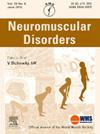RFC4基因的双等位基因变异导致一种快速进展的先天性肌病,伴严重张力低下和轴向无力
IF 2.7
4区 医学
Q2 CLINICAL NEUROLOGY
引用次数: 0
摘要
RFC4基因最近与多系统疾病森本-柳-马利丹神经肌肉综合征有关,9名患者的主要症状之一是肌病。我们报告了两个兄弟的病例,他们患有快速进展的先天性肌病,其特征是严重的低张力和轴肌无力,与以前未发表的RFC4基因双等位基因变异有关。全外显子组测序显示双等位变异NM_002916.5:c。1019_1020insCAAA和NM_002916.5:c。p.(Gly341Lysfs*4)和p.(Thr328delinsAsnSer)在两兄弟的蛋白水平变化。本病例扩展了森本-柳-马利丹神经肌肉综合征的表型谱,突出了严重的早发性轴肌无力、严重张力低下和智力发育保留。我们也提供了新的见解,临床进展和潜在的多学科干预森本-柳玛利丹神经肌肉综合征的患者。我们的研究结果强调了先进的遗传诊断和国际合作在识别罕见神经肌肉疾病和改善患者临床管理方面的重要性。本文章由计算机程序翻译,如有差异,请以英文原文为准。
Biallelic variants in the RFC4 gene cause a rapidly progressive congenital myopathy with severe hypotonia and axial weakness
The RFC4 gene has recently been linked to a multisystemic disorder Morimoto-Ryu-Malicdan neuromuscular syndrome, with myopathy being one of the key symptoms described in nine patients. We report the case of two brothers with a rapidly progressive congenital myopathy characterized by severe hypotonia and axial muscle weakness associated with previously unpublished biallelic variants in the RFC4 gene. Whole exome sequencing revealed biallelic variants NM_002916.5:c.1019_1020insCAAA and NM_002916.5:c.982_983insACT, corresponding to the protein-level changes p.(Gly341Lysfs*4) and p.(Thr328delinsAsnSer) in both brothers. This case expands the phenotypic spectrum of Morimoto-Ryu-Malicdan neuromuscular syndrome, highlighting severe early-onset axial muscle weakness, severe hypotonia, and preserved intellectual development. We also provide novel insights into the clinical progression and potential multidisciplinary interventions for patients with Morimoto-Ryu-Malicdan neuromuscular syndrome. Our findings highlight the importance of advanced genetic diagnostics and international collaboration in identifying rare neuromuscular diseases and improving the clinical management of affected patients.
求助全文
通过发布文献求助,成功后即可免费获取论文全文。
去求助
来源期刊

Neuromuscular Disorders
医学-临床神经学
CiteScore
4.60
自引率
3.60%
发文量
543
审稿时长
53 days
期刊介绍:
This international, multidisciplinary journal covers all aspects of neuromuscular disorders in childhood and adult life (including the muscular dystrophies, spinal muscular atrophies, hereditary neuropathies, congenital myopathies, myasthenias, myotonic syndromes, metabolic myopathies and inflammatory myopathies).
The Editors welcome original articles from all areas of the field:
• Clinical aspects, such as new clinical entities, case studies of interest, treatment, management and rehabilitation (including biomechanics, orthotic design and surgery).
• Basic scientific studies of relevance to the clinical syndromes, including advances in the fields of molecular biology and genetics.
• Studies of animal models relevant to the human diseases.
The journal is aimed at a wide range of clinicians, pathologists, associated paramedical professionals and clinical and basic scientists with an interest in the study of neuromuscular disorders.
 求助内容:
求助内容: 应助结果提醒方式:
应助结果提醒方式:


